Greenhouse gas emissions from piggery and biogas digesters in the north of Viet Nam
Increases in pig farm densities have caused great pressures on waste
management systems and produce massive manure and urine
quantities in Vietnam. This study aimed to identify the role and
contributions of biogas digesters to better manage the sources of
greenhouse gas (GHG) emissions from pig wastes for different types
of pig farms in the north of Vietnam. Four provinces, namely Thanh
Hoa, Phu Tho, Thai Binh, and Vinh Phuc, were identified. A total of
24 farms were purposively selected including 16 small-size farms
and 8 larger-size farms. The findings showed that GHG emissions
from small-size farms (154.8 t CO2-eq.yr-1) did not significantly
differ from the amounts measured in larger-size farms (139.1 t CO2-
eq.yr-1) in the four surveyed provinces. The sampling position did
not significantly affect the GHG emission rates, with 173.9 t CO2-
eq.yr-1 inside piggeries and 120.8 t CO2-eq.yr-1 outside the outlet of
the biogas digesters (p-value = 0.09). N2O emissions require further
measurements at different farm sizes and sites. These results
confirmed that the pig waste management of biogas digesters for
both small-size and larger-size pig farms is not completely efficient
and that efforts need to be invested in to mitigate GHG emissions in
pig production. Reducing pig density per piggery is highly
recommended. The application of other alternative aerobic or
anaerobic digestion technologies like vermicompost, effective
microorganisms, and composting should also be encouraged and
promoted.
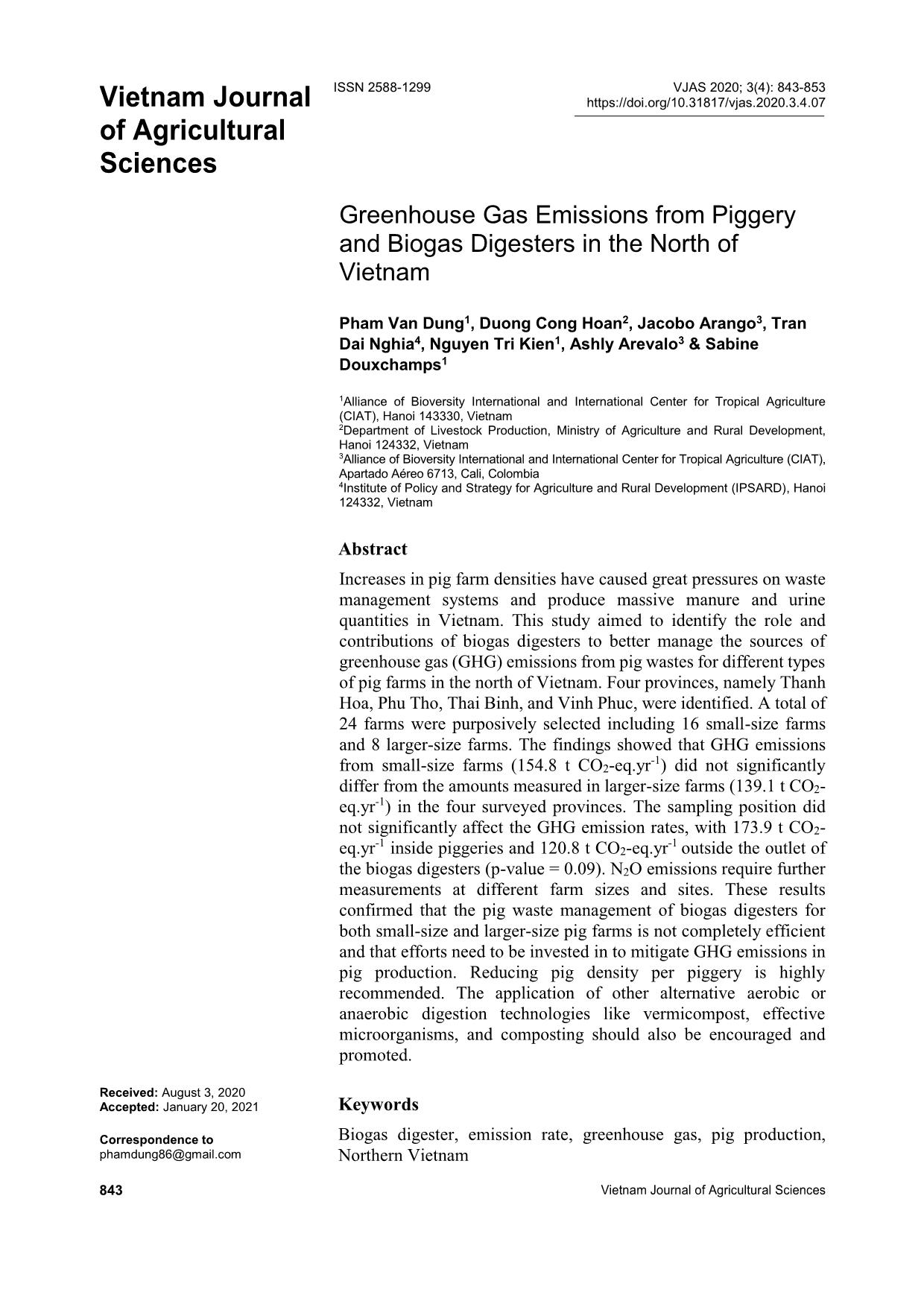
Trang 1
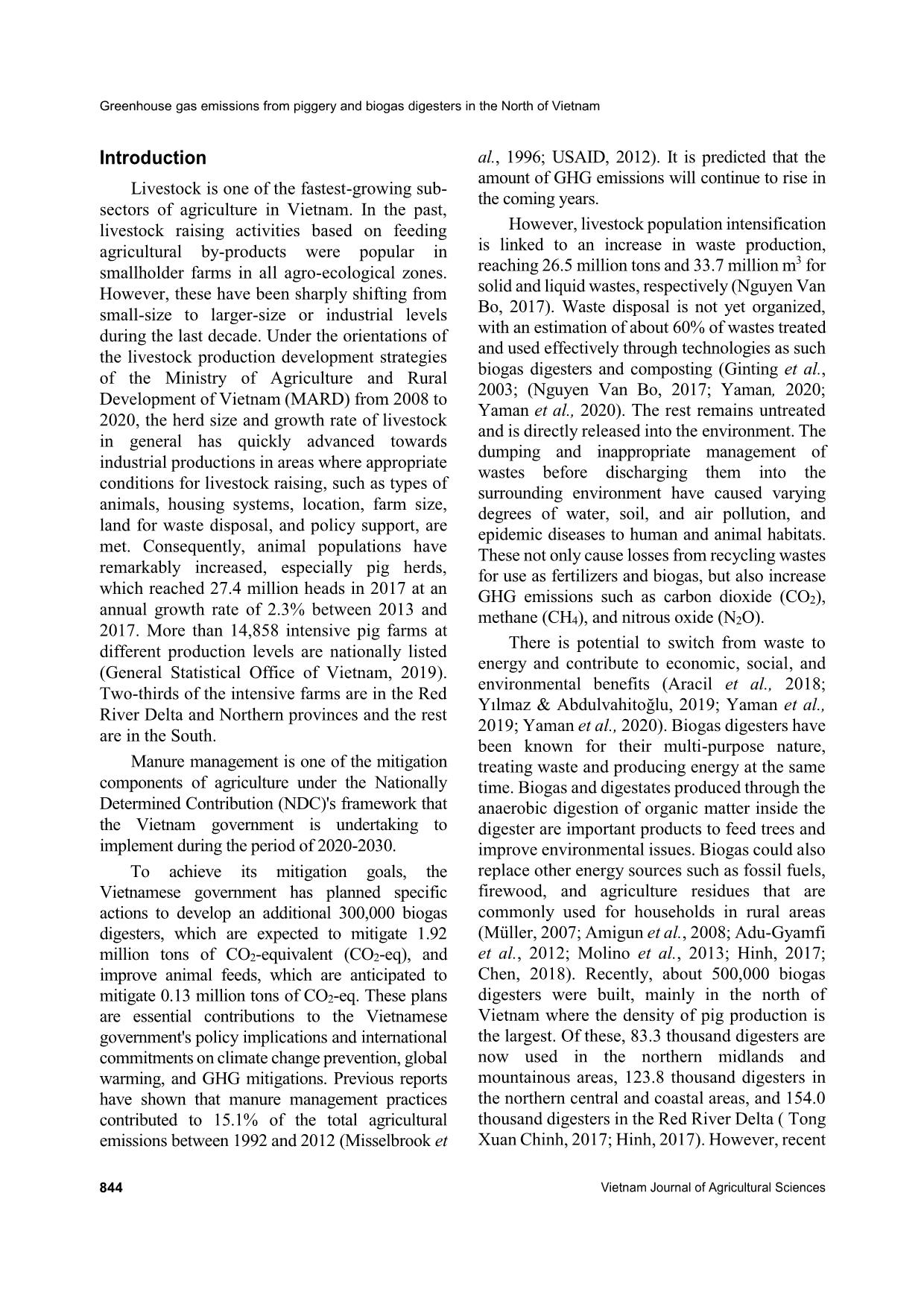
Trang 2
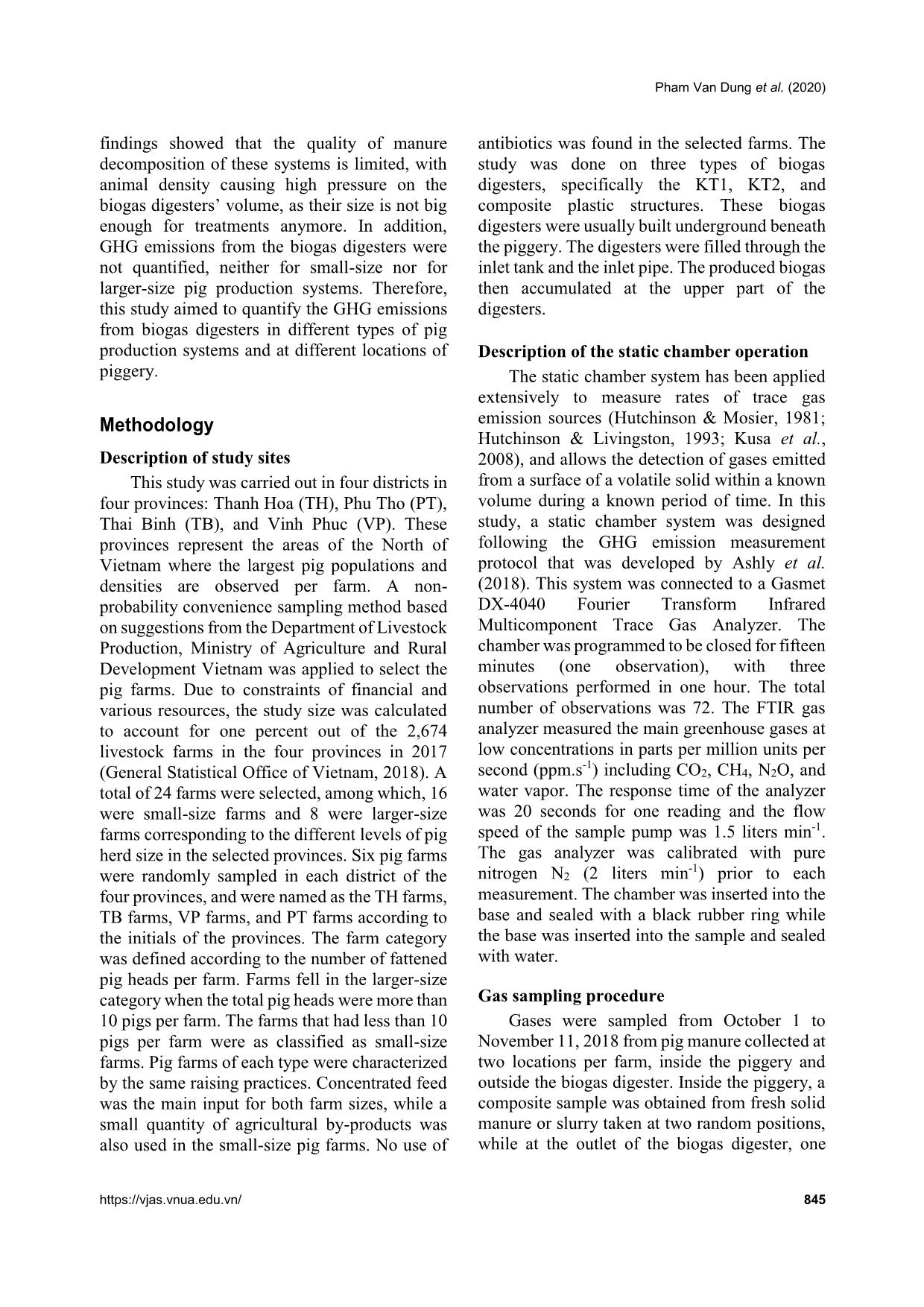
Trang 3
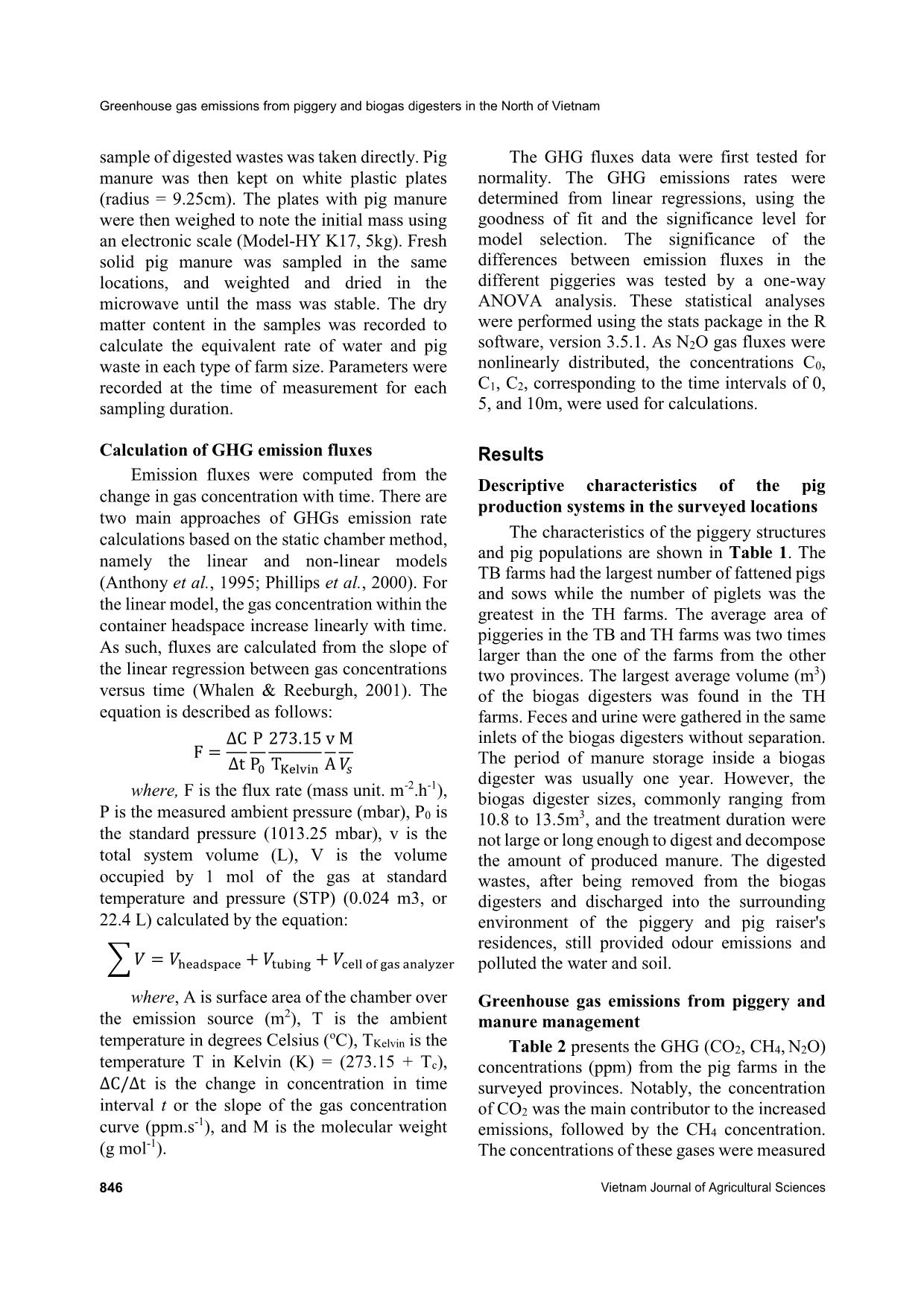
Trang 4
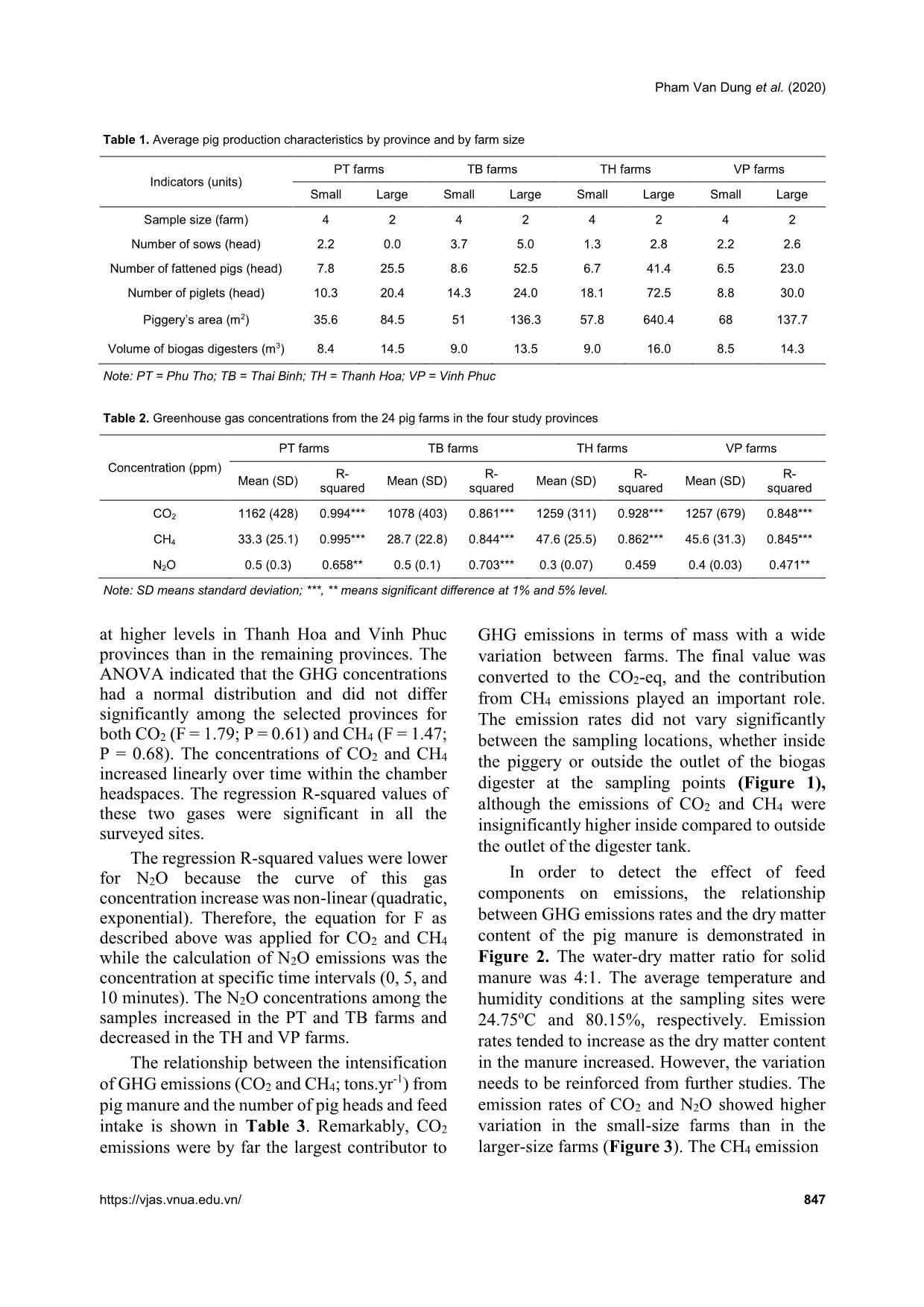
Trang 5
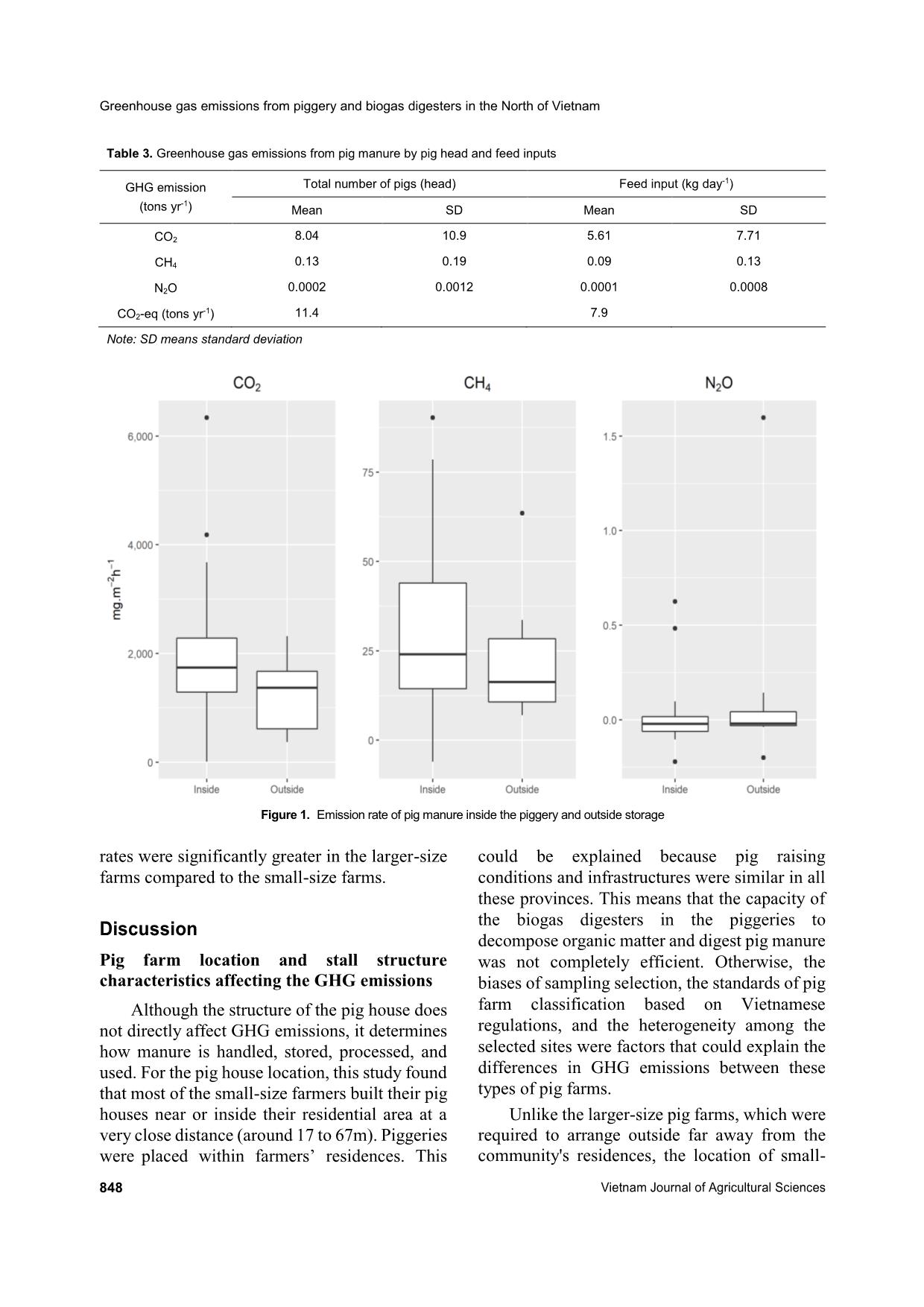
Trang 6
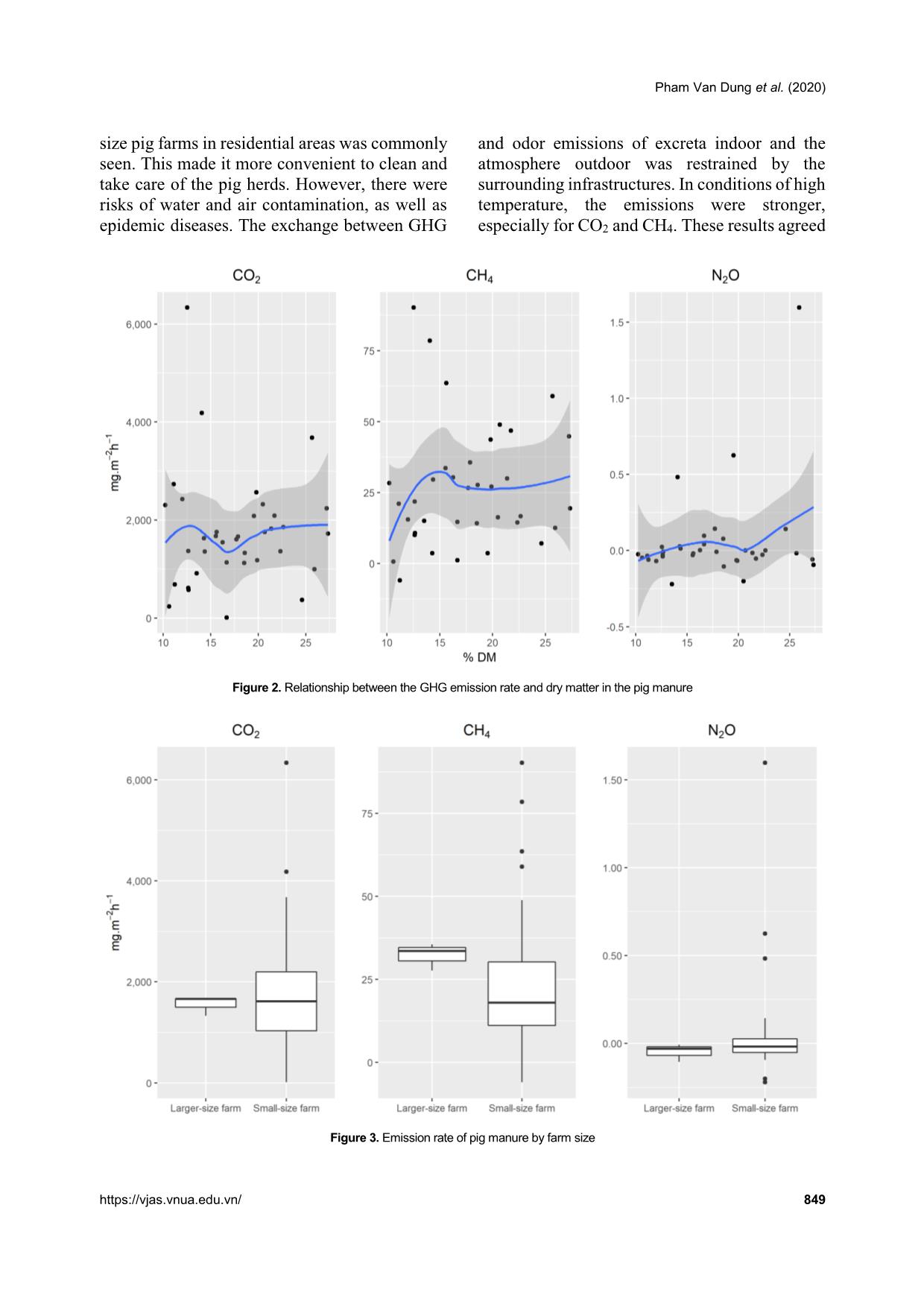
Trang 7
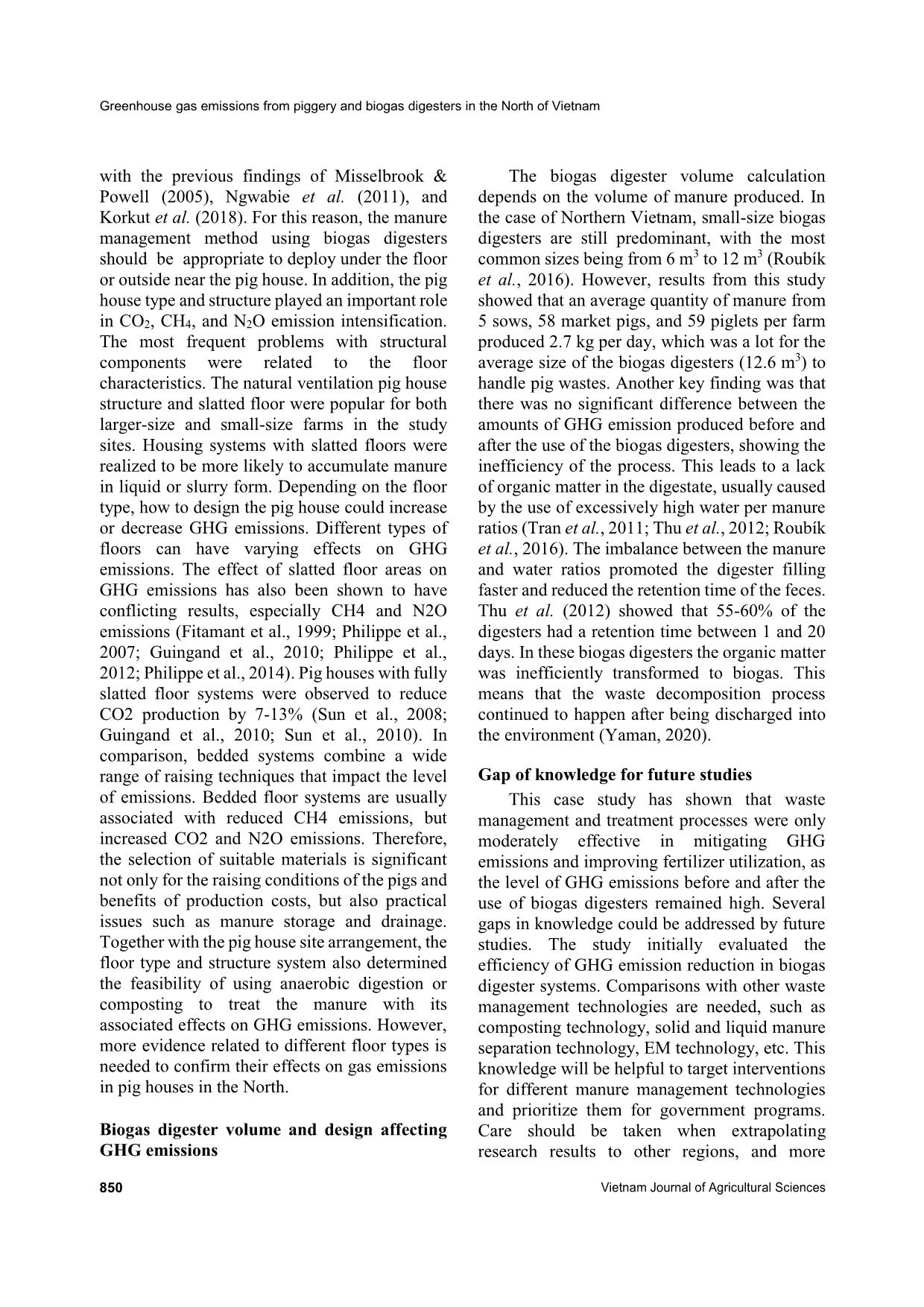
Trang 8
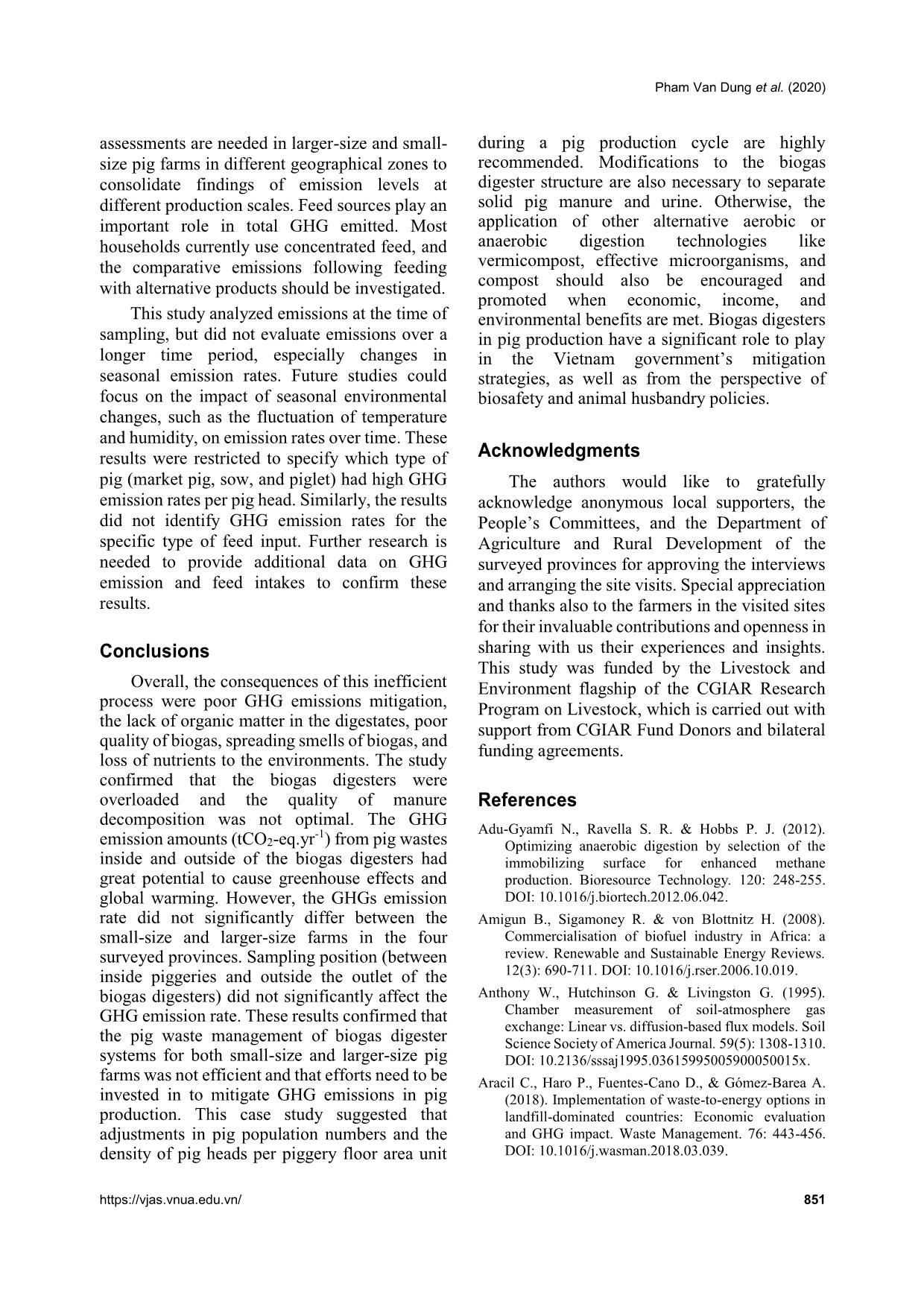
Trang 9
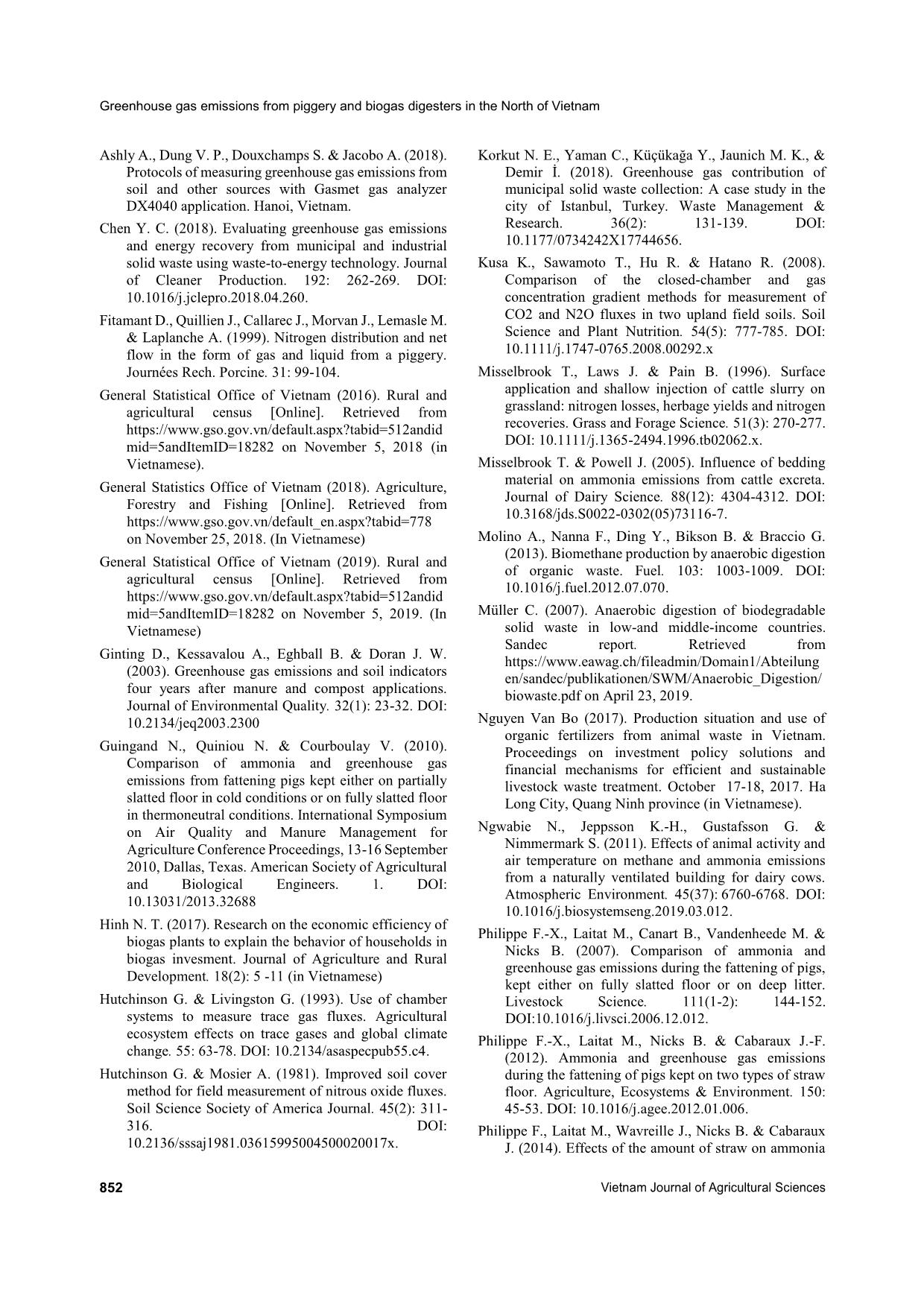
Trang 10
Tải về để xem bản đầy đủ
Tóm tắt nội dung tài liệu: Greenhouse gas emissions from piggery and biogas digesters in the north of Viet Nam
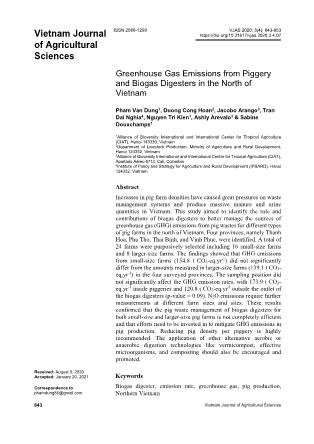
Vietnam Journal of Agricultural Sciences ISSN 2588-1299 VJAS 2020; 3(4): 843-853 https://doi.org/10.31817/vjas.2020.3.4.07 843 Vietnam Journal of Agricultural Sciences Received: August 3, 2020 Accepted: January 20, 2021 Correspondence to phamdung86@gmail.com Greenhouse Gas Emissions from Piggery and Biogas Digesters in the North of Vietnam Pham Van Dung1, Duong Cong Hoan2, Jacobo Arango3, Tran Dai Nghia4, Nguyen Tri Kien1, Ashly Arevalo3 & Sabine Douxchamps1 1Alliance of Bioversity International and International Center for Tropical Agriculture (CIAT), Hanoi 143330, Vietnam 2Department of Livestock Production, Ministry of Agriculture and Rural Development, Hanoi 124332, Vietnam 3Alliance of Bioversity International and International Center for Tropical Agriculture (CIAT), Apartado Aéreo 6713, Cali, Colombia 4Institute of Policy and Strategy for Agriculture and Rural Development (IPSARD), Hanoi 124332, Vietnam Abstract Increases in pig farm densities have caused great pressures on waste management systems and produce massive manure and urine quantities in Vietnam. This study aimed to identify the role and contributions of biogas digesters to better manage the sources of greenhouse gas (GHG) emissions from pig wastes for different types of pig farms in the north of Vietnam. Four provinces, namely Thanh Hoa, Phu Tho, Thai Binh, and Vinh Phuc, were identified. A total of 24 farms were purposively selected including 16 small-size farms and 8 larger-size farms. The findings showed that GHG emissions from small-size farms (154.8 t CO2-eq.yr -1) did not significantly differ from the amounts measured in larger-size farms (139.1 t CO2- eq.yr-1) in the four surveyed provinces. The sampling position did not significantly affect the GHG emission rates, with 173.9 t CO2- eq.yr-1 inside piggeries and 120.8 t CO2-eq.yr -1 outside the outlet of the biogas digesters (p-value = 0.09). N2O emissions require further measurements at different farm sizes and sites. These results confirmed that the pig waste management of biogas digesters for both small-size and larger-size pig farms is not completely efficient and that efforts need to be invested in to mitigate GHG emissions in pig production. Reducing pig density per piggery is highly recommended. The application of other alternative aerobic or anaerobic digestion technologies like vermicompost, effective microorganisms, and composting should also be encouraged and promoted. Keywords Biogas digester, emission rate, greenhouse gas, pig production, Northern Vietnam Greenhouse gas emissions from piggery and biogas digesters in the North of Vietnam 844 Vietnam Journal of Agricultural Sciences Introduction Livestock is one of the fastest-growing sub- sectors of agriculture in Vietnam. In the past, livestock raising activities based on feeding agricultural by-products were popular in smallholder farms in all agro-ecological zones. However, these have been sharply shifting from small-size to larger-size or industrial levels during the last decade. Under the orientations of the livestock production development strategies of the Ministry of Agriculture and Rural Development of Vietnam (MARD) from 2008 to 2020, the herd size and growth rate of livestock in general has quickly advanced towards industrial productions in areas where appropriate conditions for livestock raising, such as types of animals, housing systems, location, farm size, land for waste disposal, and policy support, are met. Consequently, animal populations have remarkably increased, especially pig herds, which reached 27.4 million heads in 2017 at an annual growth rate of 2.3% between 2013 and 2017. More than 14,858 intensive pig farms at different production levels are nationally listed (General Statistical Office of Vietnam, 2019). Two-thirds of the intensive farms are in the Red River Delta and Northern provinces and the rest are in the South. Manure management is one of the mitigation components of agriculture under the Nationally Determined Contribution (NDC)'s framework that the Vietnam government is undertaking to implement during the period of 2020-2030. To achieve its mitigation goals, the Vietnamese government has planned specific actions to develop an additional 300,000 biogas digesters, which are expected to mitigate 1.92 million tons of CO2-equivalent (CO2-eq), and improve animal feeds, which are anticipated to mitigate 0.13 million tons of CO2-eq. These plans are essential contributions to the Vietnamese government's policy implications and international commitments on climate change prevention, global warming, and GHG mitigations. Previous reports have shown that manure management practices contributed to 15.1% of the total agricultural emissions between 1992 and 2012 (Misselbrook et al., 1996; USAID, 2012). I ... before and after the use of biogas digesters remained high. Several gaps in knowledge could be addressed by future studies. The study initially evaluated the efficiency of GHG emission reduction in biogas digester systems. Comparisons with other waste management technologies are needed, such as composting technology, solid and liquid manure separation technology, EM technology, etc. This knowledge will be helpful to target interventions for different manure management technologies and prioritize them for government programs. Care should be taken when extrapolating research results to other regions, and more Pham Van Dung et al. (2020) https://vjas.vnua.edu.vn/ 851 assessments are needed in larger-size and small- size pig farms in different geographical zones to consolidate findings of emission levels at different production scales. Feed sources play an important role in total GHG emitted. Most households currently use concentrated feed, and the comparative emissions following feeding with alternative products should be investigated. This study analyzed emissions at the time of sampling, but did not evaluate emissions over a longer time period, especially changes in seasonal emission rates. Future studies could focus on the impact of seasonal environmental changes, such as the fluctuation of temperature and humidity, on emission rates over time. These results were restricted to specify which type of pig (market pig, sow, and piglet) had high GHG emission rates per pig head. Similarly, the results did not identify GHG emission rates for the specific type of feed input. Further research is needed to provide additional data on GHG emission and feed intakes to confirm these results. Conclusions Overall, the consequences of this inefficient process were poor GHG emissions mitigation, the lack of organic matter in the digestates, poor quality of biogas, spreading smells of biogas, and loss of nutrients to the environments. The study confirmed that the biogas digesters were overloaded and the quality of manure decomposition was not optimal. The GHG emission amounts (tCO2-eq.yr -1) from pig wastes inside and outside of the biogas digesters had great potential to cause greenhouse effects and global warming. However, the GHGs emission rate did not significantly differ between the small-size and larger-size farms in the four surveyed provinces. Sampling position (between inside piggeries and outside the outlet of the biogas digesters) did not significantly affect the GHG emission rate. These results confirmed that the pig waste management of biogas digester systems for both small-size and larger-size pig farms was not efficient and that efforts need to be invested in to mitigate GHG emissions in pig production. This case study suggested that adjustments in pig population numbers and the density of pig heads per piggery floor area unit during a pig production cycle are highly recommended. Modifications to the biogas digester structure are also necessary to separate solid pig manure and urine. Otherwise, the application of other alternative aerobic or anaerobic digestion technologies like vermicompost, effective microorganisms, and compost should also be encouraged and promoted when economic, income, and environmental benefits are met. Biogas digesters in pig production have a significant role to play in the Vietnam government’s mitigation strategies, as well as from the perspective of biosafety and animal husbandry policies. Acknowledgments The authors would like to gratefully acknowledge anonymous local supporters, the People’s Committees, and the Department of Agriculture and Rural Development of the surveyed provinces for approving the interviews and arranging the site visits. Special appreciation and thanks also to the farmers in the visited sites for their invaluable contributions and openness in sharing with us their experiences and insights. This study was funded by the Livestock and Environment flagship of the CGIAR Research Program on Livestock, which is carried out with support from CGIAR Fund Donors and bilateral funding agreements. References Adu-Gyamfi N., Ravella S. R. & Hobbs P. J. (2012). Optimizing anaerobic digestion by selection of the immobilizing surface for enhanced methane production. Bioresource Technology. 120: 248-255. DOI: 10.1016/j.biortech.2012.06.042. Amigun B., Sigamoney R. & von Blottnitz H. (2008). Commercialisation of biofuel industry in Africa: a review. Renewable and Sustainable Energy Reviews. 12(3): 690-711. DOI: 10.1016/j.rser.2006.10.019. Anthony W., Hutchinson G. & Livingston G. (1995). Chamber measurement of soil‐atmosphere gas exchange: Linear vs. diffusion‐based flux models. Soil Science Society of America Journal. 59(5): 1308-1310. DOI: 10.2136/sssaj1995.03615995005900050015x. Aracil C., Haro P., Fuentes-Cano D., & Gómez-Barea A. (2018). Implementation of waste-to-energy options in landfill-dominated countries: Economic evaluation and GHG impact. Waste Management. 76: 443-456. DOI: 10.1016/j.wasman.2018.03.039. Greenhouse gas emissions from piggery and biogas digesters in the North of Vietnam 852 Vietnam Journal of Agricultural Sciences Ashly A., Dung V. P., Douxchamps S. & Jacobo A. (2018). Protocols of measuring greenhouse gas emissions from soil and other sources with Gasmet gas analyzer DX4040 application. Hanoi, Vietnam. Chen Y. C. (2018). Evaluating greenhouse gas emissions and energy recovery from municipal and industrial solid waste using waste-to-energy technology. Journal of Cleaner Production. 192: 262-269. DOI: 10.1016/j.jclepro.2018.04.260. Fitamant D., Quillien J., Callarec J., Morvan J., Lemasle M. & Laplanche A. (1999). Nitrogen distribution and net flow in the form of gas and liquid from a piggery. Journées Rech. Porcine. 31: 99-104. General Statistical Office of Vietnam (2016). Rural and agricultural census [Online]. Retrieved from https://www.gso.gov.vn/default.aspx?tabid=512andid mid=5andItemID=18282 on November 5, 2018 (in Vietnamese). General Statistics Office of Vietnam (2018). Agriculture, Forestry and Fishing [Online]. Retrieved from https://www.gso.gov.vn/default_en.aspx?tabid=778 on November 25, 2018. (In Vietnamese) General Statistical Office of Vietnam (2019). Rural and agricultural census [Online]. Retrieved from https://www.gso.gov.vn/default.aspx?tabid=512andid mid=5andItemID=18282 on November 5, 2019. (In Vietnamese) Ginting D., Kessavalou A., Eghball B. & Doran J. W. (2003). Greenhouse gas emissions and soil indicators four years after manure and compost applications. Journal of Environmental Quality. 32(1): 23-32. DOI: 10.2134/jeq2003.2300 Guingand N., Quiniou N. & Courboulay V. (2010). Comparison of ammonia and greenhouse gas emissions from fattening pigs kept either on partially slatted floor in cold conditions or on fully slatted floor in thermoneutral conditions. International Symposium on Air Quality and Manure Management for Agriculture Conference Proceedings, 13-16 September 2010, Dallas, Texas. American Society of Agricultural and Biological Engineers. 1. DOI: 10.13031/2013.32688 Hinh N. T. (2017). Research on the economic efficiency of biogas plants to explain the behavior of households in biogas invesment. Journal of Agriculture and Rural Development. 18(2): 5 -11 (in Vietnamese) Hutchinson G. & Livingston G. (1993). Use of chamber systems to measure trace gas fluxes. Agricultural ecosystem effects on trace gases and global climate change. 55: 63-78. DOI: 10.2134/asaspecpub55.c4. Hutchinson G. & Mosier A. (1981). Improved soil cover method for field measurement of nitrous oxide fluxes. Soil Science Society of America Journal. 45(2): 311- 316. DOI: 10.2136/sssaj1981.03615995004500020017x. Korkut N. E., Yaman C., Küçükağa Y., Jaunich M. K., & Demir İ. (2018). Greenhouse gas contribution of municipal solid waste collection: A case study in the city of Istanbul, Turkey. Waste Management & Research. 36(2): 131-139. DOI: 10.1177/0734242X17744656. Kusa K., Sawamoto T., Hu R. & Hatano R. (2008). Comparison of the closed-chamber and gas concentration gradient methods for measurement of CO2 and N2O fluxes in two upland field soils. Soil Science and Plant Nutrition. 54(5): 777-785. DOI: 10.1111/j.1747-0765.2008.00292.x Misselbrook T., Laws J. & Pain B. (1996). Surface application and shallow injection of cattle slurry on grassland: nitrogen losses, herbage yields and nitrogen recoveries. Grass and Forage Science. 51(3): 270-277. DOI: 10.1111/j.1365-2494.1996.tb02062.x. Misselbrook T. & Powell J. (2005). Influence of bedding material on ammonia emissions from cattle excreta. Journal of Dairy Science. 88(12): 4304-4312. DOI: 10.3168/jds.S0022-0302(05)73116-7. Molino A., Nanna F., Ding Y., Bikson B. & Braccio G. (2013). Biomethane production by anaerobic digestion of organic waste. Fuel. 103: 1003-1009. DOI: 10.1016/j.fuel.2012.07.070. Müller C. (2007). Anaerobic digestion of biodegradable solid waste in low-and middle-income countries. Sandec report. Retrieved from https://www.eawag.ch/fileadmin/Domain1/Abteilung en/sandec/publikationen/SWM/Anaerobic_Digestion/ biowaste.pdf on April 23, 2019. Nguyen Van Bo (2017). Production situation and use of organic fertilizers from animal waste in Vietnam. Proceedings on investment policy solutions and financial mechanisms for efficient and sustainable livestock waste treatment. October 17-18, 2017. Ha Long City, Quang Ninh province (in Vietnamese). Ngwabie N., Jeppsson K.-H., Gustafsson G. & Nimmermark S. (2011). Effects of animal activity and air temperature on methane and ammonia emissions from a naturally ventilated building for dairy cows. Atmospheric Environment. 45(37): 6760-6768. DOI: 10.1016/j.biosystemseng.2019.03.012. Philippe F.-X., Laitat M., Canart B., Vandenheede M. & Nicks B. (2007). Comparison of ammonia and greenhouse gas emissions during the fattening of pigs, kept either on fully slatted floor or on deep litter. Livestock Science. 111(1-2): 144-152. DOI:10.1016/j.livsci.2006.12.012. Philippe F.-X., Laitat M., Nicks B. & Cabaraux J.-F. (2012). Ammonia and greenhouse gas emissions during the fattening of pigs kept on two types of straw floor. Agriculture, Ecosystems & Environment. 150: 45-53. DOI: 10.1016/j.agee.2012.01.006. Philippe F., Laitat M., Wavreille J., Nicks B. & Cabaraux J. (2014). Effects of the amount of straw on ammonia Pham Van Dung et al. (2020) https://vjas.vnua.edu.vn/ 853 and greenhouse gases emissions associated to fattening pigs kept on deep litter. Journées Rech. Porcine. 46: 213-214. DOI: 10.1016/j.agee.2014.08.015. Phillips V., Scholtens R., Lee D., Garland J. & Sneath R. (2000). A review of methods for measuring emission rates of ammonia from livestock buildings and slurry or manure stores, part 1: assessment of basic approaches. Journal of Agricultural Engineering Research. 77(4): 355-364. DOI: 10.1006/jaer.2000.0613. Roubík H., Mazancová J., Banout J. & Verner V. (2016). Addressing problems at small-scale biogas plants: a case study from central Vietnam. Journal of Cleaner Production. 112: 2784-2792. DOI: 10.1016/j.jclepro.2015.09.114. Sun G., Guo H. & Peterson J. (2010). Seasonal odor, ammonia, hydrogen sulfide, and carbon dioxide concentrations and emissions from swine grower- finisher rooms. Journal of the Air and Waste Management Association. 60(4): 471-480. DOI: 10.3155/1047-3289.60.4.471. Sun G., Guo H., Peterson J., Predicala B. & Laguë C. (2008). Diurnal odor, ammonia, hydrogen sulfide, and carbon dioxide emission profiles of confined swine grower/finisher rooms. Journal of the Air & Waste Management Association. 58(11): 1434-1448. DOI: 10.3155/1047-3289.58.11.1434. Thu C. T. T., Cuong P. H., Van Chao N., Trach N. X. & Sommer S. G. (2012). Manure management practices on biogas and non-biogas pig farms in developing countries–using livestock farms in Vietnam as an example. Journal of Cleaner Production. 27: 64-71. DOI: 10.1016/j.jclepro.2012.01.006. Tong Xuan Chinh (2017). Current situation and solutions for livestock waste treatment. Evaluation of livestock waste treatment technology on smallholder farm scale. December 07th, 2017. Ho Chi Minh city [Online]. Retrieved from danh-gia-cong-nghe-xu-ly-chat-thai-chan-nuoi-quy- mo-trang-trai-351.html on January 19, 2020 (in Vietnamese). Tran M., Vu T., Sommer S. G. & Jensen L. S. (2011). Nitrogen turnover and loss during storage of slurry and composting of solid manure under typical Vietnamese farming conditions. The Journal of Agricultural Science. 149(3): 285. DOI: 10.1017/S0021859610000699. USAID (2012). Greenhouse Gas Emissions Factsheet: Vietnam. The United States Agency for International Development [Online]. Retrieved from https://www.climatelinks.org/sites/default/files/as set/document/Vietnam%20Fact%20Sheet%20- %20rev%2010%2007%2016_Final.pdf on April 25, 2019. Whalen S. & Reeburgh W. (2001). Carbon monoxide consumption in upland boreal forest soils. Soil Biology and Biochemistry. 33(10): 1329-1338. DOI: 10.1016/S0038-0717(01)00038-4. Yaman C. (2020). Application of Sterilization Process for Inactivation of Bacillus Stearothermophilus in Biomedical Waste and Associated Greenhouse Gas Emissions. Applied Sciences. 10(15): 5056. DOI: 10.3390/app10155056. Yaman C. (2020). Investigation of greenhouse gas emissions and energy recovery potential from municipal solid waste management practices. Environmental Development. 33: 100484. DOI: 10.1016/j.envdev.2019.100484. Yaman C. (2020). Monitoring of Biochemical Parameters and GHG Emissions in Bioaugmented Manure Composting. Processes. 8(6): 681. DOI: 10.3390/pr8060681. Yaman C., Anil I., & Alagha O. (2020). Potential for greenhouse gas reduction and energy recovery from MSW through different waste management technologies. Journal of Cleaner Production. 264: 121432. DOI: 10.1016/j.jclepro.2020.121432. Yaman C., Anil I., Jaunich M. K., Blaisi N. I., Alagha O., Yaman A. B., & Gunday S. T. (2019). Investigation and modelling of greenhouse gas emissions resulting from waste collection and transport activities. Waste Management & Research. 37(12): 1282-1290. DOI: 10.1177/0734242X19882482. Yılmaz İ. H. & Abdulvahitoğlu A. (2019). Evaluation of municipal solid waste options in Turkey: Scenarios for energy recovery, carbon mitigation and consequent financial strategies. Resources, Conservation and Recycling. 147: 95-110. DOI: 10.1016/j.resconrec.2019.02.029.
File đính kèm:
 greenhouse_gas_emissions_from_piggery_and_biogas_digesters_i.pdf
greenhouse_gas_emissions_from_piggery_and_biogas_digesters_i.pdf

